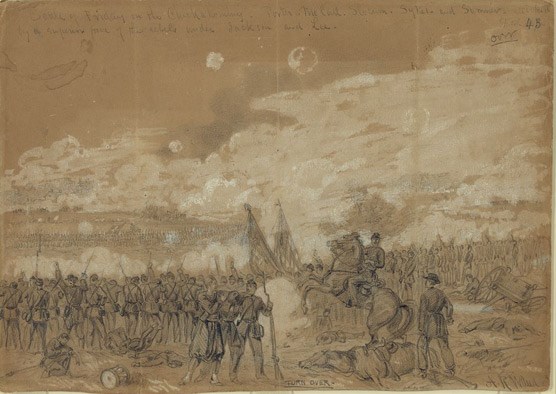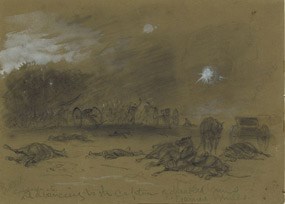
Library of Congress Despite the battlefield victory at Beaver Dam Creek on the evening of June 26, 1862, the Union Fifth Corps under Fitz John Porter abandoned the strong position there shortly after midnight. Army commander George B. McClellan, aware of an approaching Confederate column under “Stonewall” Jackson, decided to relocate his base of operations south to the James River. For the next five days his army moved toward the river, fighting a series of rearguard battles in a desperate effort to stave off triumphant Confederates. The Battle of Gaines’s Mill, on June 27, marked the first in that series of battles. McClellan deployed Porter’s Fifth Corps across an arc of 1 ½ miles, with its back to the swampy Chickahominy River. Porter recognized that his assignment was to hold off the pursuing Confederates while the balance of the Union army began its movement toward the James. With only 27,000 men, Porter had little hope of achieving any great victory, particularly when R. E. Lee brought approximately 60,000 Confederates to the attack. A small force of reenforcements elevated Porter’s strength to 34,000, but Lee enjoyed a great numerical advantage—one of the largest of the war for his army. Although not entrenched in the usual style, the Union infantry made full use of the terrain and enjoyed fine fields of fire. Abundant artillery helped Porter’s men as the battle grew in scope and violence. The initial Confederate attacks only began at about 2:30, leaving just 5 ½ hours of daylight. For both sides, the ticking clock was of critical importance. If Porter’s men could survive until sunset, darkness would shelter their withdrawal across the river. If Lee could shatter the Union line during the daylight hours, he stood a real chance of fully destroying Porter’s command by driving it into the river. 
Library of Congress For most of the afternoon the attacks of R. E. Lee's army sputtered and stalled, with substantial loss. A. P. Hill’s division began the battle, its six brigades colliding with the Federal divisions of George Sykes and George Morell. After one wrong turn, Stonewall Jackson’s wing of the army arrived and extended Lee’s force from the New Cold Harbor intersection eastward to the Old Cold Harbor crossroads. Jackson fed his divisions into the fight, producing a roar of rifle and musket fire that many veterans later remembered as the loudest they heard during the entire Civil War. The defensive power of Porter’s position played an important part in the initial success of his troops. In many places his infantry commanded long fields of fire. To reach the Fifth Corps, most Confederate attackers had to cross long open stretches where they were vulnerable to damage. On other stretches of the line, thick woods and steep slopes aided the defenders by blunting the momentum of the attackers. Finally, less than an hour before sunset, Lee hurled his combined force into a final attack—the largest single attack he ever launched during the war. His infantry broke Porter's line in at least two places, but insufficient daylight remained to overwhelm the beaten Federal force. The division of William H. C. Whiting, spearheaded by “The Texas Brigade” of John B. Hood, earned accolades for securing the first break in Porter’s line. As the Federal lines crumbled, entire regiments wandered through the smoky woods and fell into captivity at the hands of victorious Confederates. Porter’s position unraveled. The last Confederate attacks aimed at his line of reserve artillery, all that stood between the survivors of the Fifth Corps and the Chickahominy River. Charging against those massed cannon, Lee’s men absorbed shocking casualties while securing many of the trophies. In the afternoon’s action they captured two dozen Union cannon and seized control of the battlefield. But the successes occurred too late in the day to produce the total destruction of Porter’s command. Darkness obscured the battlefield, allowing the remnants of the Fifth Corps to retreat across the river and rejoin their comrades. Engineers blew up the various bridges, leaving Lee in control of the battlefield and of the Richmond and York River Railroad—the line that had supplied the Union army during the preceding six weeks of operations outside Richmond. Each side achieved its goal on June 27. Porter's men mortgaged lives (6000 total casualties, killed, wounded, and captured) to buy time for the balance of the Union army to make for the James River. The Confederates had their first large, sweeping tactical victory in Virginia since July 1861, but at the steep cost of approximately 9000 men killed and wounded. Today Richmond National Battlefield Park owns only 60 acres of this large battlefield—the largest battle of the entire Seven Days—including the spot where John B. Hood's Confederates achieved the first breakthrough in the Union line. The site is criss-crossed with walking trails and interpretive signs. The historic Watt House, centerpiece to the battlefield, still stands but is not open to the public. |
Last updated: February 26, 2015
